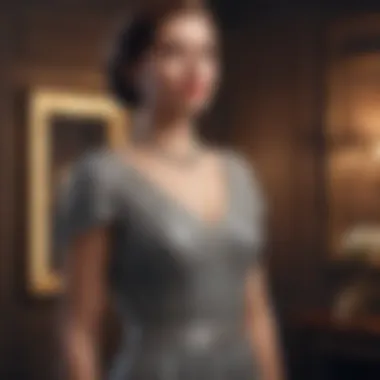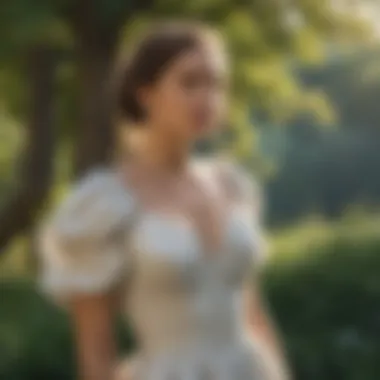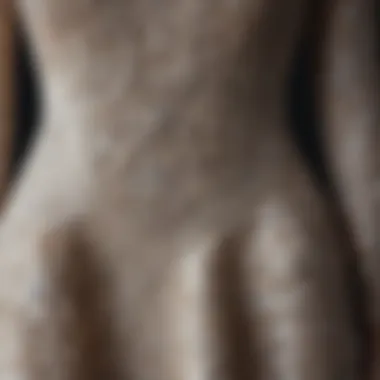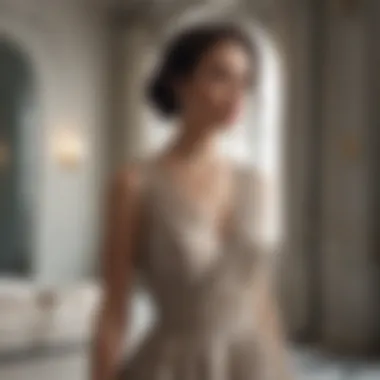The Timeless Charm of Classic Dresses in Fashion


Intro
The world of fashion is often perceived through the lens of passing trends and ephemeral designs, yet certain elements endure over time. Among these, the classic dress stands out as a symbol of elegance and poise. These garments have been reimagined through various eras. Despite this evolution, their core allure remains unchanged.
This article seeks to explore the multifaceted significance of classic dresses. It will investigate how their timeless appeal resonates with contemporary fashion, acting as a bridge between the past and present. Moreover, classic dresses are not merely articles of clothing; they also play a vital role in personal expression and cultural identity.
Fashion, while being an ever-changing industry, often looks back to its roots for inspiration. Classic dresses embody that connection to history, offering women of all ages an opportunity to express individuality while embracing style that transcends generational boundaries.
As we delve into the significance of these garments, it becomes essential to highlight the key themes of this exploration. We will cover:
- The historical context and evolution of classic dresses.
- How these garments influence personal and cultural identities.
- Practical guidance on incorporating classic styles into modern wardrobes.
Fashion Trends
The world of fashion is dynamic, with trends waxing and waning at an almost dizzying pace. Yet, amidst this flux, classic dresses maintain a steadfast position in women's wardrobes. They not only reflect elegant aesthetics but also adapt to various fashion movements.
Street Style Inspiration
Street style is a powerful force that shapes contemporary fashion. The classic dress has found a unique way of marrying tradition with modernity in the realm of street fashion. Creative styling techniques allow women to transform a vintage piece into a fresh statement.
- Pairing a classic A-line dress with a leather jacket can create a balanced look that exudes confidence.
- Accessorizing with contemporary items, such as chunky boots or oversized handbags, brings a flair that appeals to modern sensibilities.
- Layering with sweaters or cardigans can transition a summer dress into a fall staple, proving the versatility of classic designs.
Classic dresses have the ability to be dressed up or down, making them staples for street style enthusiasts. This flexibility helps women express their unique fashion tastes, showcasing how these timeless pieces can coexist with current trends.
Sustainable Fashion
As awareness around sustainability grows, the conversation around fashion also evolves. Classic dresses support the sustainable movement through their longevity and timelessness. Investing in quality classic pieces fosters a more sustainable wardrobe. Instead of succumbing to fast fashion, many women are choosing to invest in lasting styles that don't go out of favor.
- Quality over Quantity: Classic dresses are usually made with enduring materials, which often translates into durability over time.
- Timeless Trends: Unlike fleeting trends, classic styles recur in various forms, allowing their wearers to enjoy them across many seasons.
- Wardrobe Simplification: Incorporating a few classic dresses into a wardrobe leads to easier outfit planning, reducing the urge to buy new clothes frequently.
"Classic dresses allow us to connect with our heritage while making informed fashion choices for the future."
The commitment to sustainability aligns seamlessly with the charm of classic dresses, making them a wise choice amidst the fast-fashion debate.
Foreword to Beautiful Classic Dresses
Understanding classic dresses involves assessing their unique elements. These dresses not only highlight sophisticated designs but also an array of fabrics and construction methods that contribute to their lasting appeal. Their versatility ensures they can fit numerous occasions, making them a staple in wardrobes worldwide.
Incorporating classic dresses into daily life also bears benefits. They often invoke feelings of confidence and self-assuredness, serving as a powerful tool for self-expression. Additionally, exploring their cultural significance reveals layers of meaning and history that further enhance their attraction. As we dive deeper into the topic, it becomes clear that beautiful classic dresses are more than just clothing; they are a reflection of personal and collective identity.
Defining Classic Dresses
Classic dresses can be succinctly defined as garments that boast enduring styles, often characterized by tailored silhouettes and refined details. They typically feature classic colors such as black, navy, or neutrals, making them suitable for a variety of events.
Key characteristics often include:
- Silhouettes: A-line, sheath, and fit-and-flare are common shapes associated with classic dresses.
- Fabrics: Quality materials such as silk, wool, and cotton enhance the garment’s overall aesthetic.
- Details: Elements like elegant necklines, subtle embellishments, and careful construction contribute to their charm.
Understanding this definition helps clarify why these garments hold a cherished place in women’s fashion across generations.
Cultural Significance Across Eras
The cultural significance of classic dresses can vary greatly depending on historical context and societal norms. They have evolved, reflecting the changes in women’s roles, fashion sensibilities, and cultural tastes through the decades.
In earlier eras, dresses often signified status and class. For instance, during the Victorian period, the dresses were extravagant, made with rich fabrics and intricate detailing. In contrast, the flapper dresses of the 1920s reflected a shift towards more liberated styles.


"Fashion is the armor to survive the reality of everyday life."
Through the years, various influential figures have embraced and popularized classic dress styles. Icons such as Audrey Hepburn and Jackie Kennedy have left indelible marks, solidifying their place in fashion history. Today, classic dresses continue to signify elegance, poise, and the essence of femininity. By examining this cultural journey, we appreciate not only the garments themselves but also the stories they tell.
Historical Evolution of Dress Styles
The evolution of dress styles serves as a crucial lens through which we can understand the significance of classic dresses in contemporary fashion. This retrospective not only highlights how societal changes influence attire but also demonstrates the enduring qualities that make certain styles timeless. Classic dresses are not merely artifacts; they encapsulate cultural narratives that reflect the prevailing attitudes and values of various eras. As we examine the historical context, we can appreciate their role in shaping personal identity and cultural expressions.
Early Influences in Fashion
Fashion has long been a mirror to the society of its time. Early influences can be traced back to various regions and cultures which showcased unique textiles and silhouettes. For instance, during the Renaissance period, the emphasis on elaborate designs and rich fabrics correlated with the growing wealth and status of the bourgeoisie. Influential styles emerged from this era, characterized by fitted bodices and flowing skirts, which laid the groundwork for the development of classic dresses.
In the 18th century, certain styles, such as the empire waist and the use of lighter fabrics, began to emerge. The Napoleonic era influenced French fashion with a more relaxed silhouette, allowing women to embrace comfort and elegance simultaneously. This period marked the birth of dresses that showcased a natural waistline, emphasizing simplicity while still providing a sense of sophistication.
The Impact of Iconic Fashion Figures
Throughout history, there have been key figures in fashion who have not only set trends but also altered the trajectory of dress styles. Designers such as Coco Chanel and Christian Dior played vital roles in reshaping the definition of femininity through their groundbreaking creations. Chanel’s introduction of the little black dress in the 1920s exemplified classic elegance combined with wearability, breaking traditional norms that dictated formal style.
On the other hand, Dior’s “New Look” from the late 1940s brought back opulence with its cinched waists and voluminous skirts, re-establishing a sense of glamour after the austerity of World War II. These iconic figures did more than just create dresses; they influenced cultural attitudes towards women's fashion and identity. Their work illustrates how dress styles evolve in response to both personal and societal demands, making them an integral part of the fashion narrative.
As we delve deeper into the evolution of dress styles, it is apparent that classic dresses emerge not only as a matter of aesthetic preference but also as a reflection of changing times and ideals. Understanding this historical backdrop enriches our appreciation for the allure of these timeless garments.
Key Elements of Classic Dresses
Classic dresses hold a unique place in fashion predicated on their elegance and adaptability. Understanding the key elements that define these dresses provides insights into why they continue to captivate women across generations. The elements we will examine are timeless silhouettes, quality fabrics, craftsmanship, and enduring color palettes. Each element contributes significantly to the overall appeal and relevance of classic dresses today.
Timeless Silhouettes
Timeless silhouettes are foundational to classic dresses. These shapes, such as the A-line, sheath, and fit-and-flare, flatter various body types and enhance the wearer’s figure. A well-cut silhouette can transform an ordinary dress into something exceptional. For instance, the A-line silhouette offers a gentle taper from the bodice to the hem, creating a graceful look. Similarly, the sheath style, known for its form-fitting appearance, accentuates curves and projects confidence.
Women often choose silhouettes based on comfort and confidence. Investing in styles like the wrap dress, popularized by Diane von Furstenberg, allows for versatility. The wrap dress is adaptable for different occasions from casual gatherings to formal events, affirming its timeless status.
"A dress is not just clothing; it's a statement of self."
Quality Fabrics and Craftsmanship
Quality fabrics and craftsmanship are crucial in the allure of classic dresses. Fabrics such as silk, wool, cotton, and linen not only offer aesthetic appeal but also longevity. The feel of the fabric against the skin plays a vital role in the overall experience of wearing a classic dress.
Furthermore, meticulous craftsmanship ensures that each garment fits well and retains its shape over time. Techniques like double-stitching and hand-sewn details contribute to the durability of a dress. Brands renowned for their craftsmanship, such as Chanel and Dior, maintain high standards, resulting in garments that remain timeless.
When considering a classic dress, it is essential to prioritize quality over quantity. Investing in one well-made piece often proves more beneficial than multiple cheaper options. This approach underlies a sustainable fashion ethos, promoting longevity in the wardrobe.
Color Palettes that Endure
Choosing the right color is essential for the timeless appeal of classic dresses. Neutral tones like black, white, navy, and beige are repeatedly favored. These colors provide versatility, seamlessly transitioning from day to night. For instance, a little black dress can be accessorized in myriad ways, catering to various occasions.
In addition to neutrals, certain jewel tones and pastels have a lasting charm that enhances classic designs. Soft hues work wonderfully in spring and summer months, while deeper tones resonate well in fall and winter. The right color can evoke different moods and sentiments.
Classic dresses encourage women to embrace colors that resonate with their personal style. Ultimately, these choices foster an enduring wardrobe that reflects individual personality and taste.
Classic Dresses in Contemporary Wardrobes
Classic dresses hold a unique place in today's fashion landscape. Unlike fleeting trends, these garments offer a blend of elegance and versatility, making them ideal for various settings. Whether attending a formal event or aiming for a polished everyday look, classic dresses serve as a reliable foundation in any wardrobe.
Styling Classic Dresses for Everyday Wear


Incorporating classic dresses into daily outfits can elevate style without excessive effort. To achieve a sophisticated yet casual appearance, consider selecting dresses that fit well and flatter your body shape. Opt for fabrics that are comfortable, such as cotton or linen for warm weather, and wool or jersey in cooler months. These materials allow for ease of movement and comfort.
Patterns, such as stripes or florals, can add a fresh vibe while remaining timeless. Accessorizing plays a crucial role to transition a classic dress into something suitable for daily wear. Pair a classic A-line dress with a denim jacket; this combination strikes a balance between chic and relaxed, ideal for brunch or running errands.
Accessorizing for Modern Appeal
Accessories can significantly alter the feel of a classic dress. Experimenting with modern elements can create a unique style while respecting the fundamentals of classic design. Jewelry choices like bold earrings or layered necklaces can draw attention and personalize the look. Consider footwear as well; ankle boots or trendy sneakers can disrupt the traditional silhouette and add an edgy touch.
Additionally, handbags can also modernize a classic dress. A structured tote or a crossbody bag can provide practicality while adding a contemporary flair. Belts can define the waist and show off the silhouette. This approach maintains the integrity of the classic style while allowing for a fresh interpretation in today’s context.
Mixing Classic and Trendy Pieces
The merging of classic garments with trendy items can result in striking outfits. To create balance, select one classic piece as the focal point, then introduce trendy items gradually. For instance, pairing a classic wrap dress with a vibrant, oversized blazer can create contrast and interest without overwhelming the outfit.
When mixing styles, consider color coordination as essential. Keep a cohesive color scheme, focusing on complimentary tones, which can ease the transition between different styles. The combination of textures can also play a vital role; pairing a silk dress with a textured leather jacket offers depth and character.
In summary, this approach allows for personal expression through fashion, emphasizing that classic dresses can serve as a blank canvas for diverse styles. This duality makes classic dresses vital for contemporary wardrobes, ensuring they remain relevant in evolving fashion landscapes.
Classic dresses are not merely items of clothing; they are a testament to individuality and personal style.
By carefully considering how classic dresses fit into modern wardrobes, individuals can enhance their personal style while enjoying the elegance these timeless pieces offer.
Classic Dresses Across Different Cultures
The exploration of classic dresses across different cultures provides ample insight into how fashion mirrors societal values, beliefs, and traditions. Each region boasts unique designs that tell stories of heritage and identity. Understanding these variables offers a deeper appreciation for the garments that have transcended time and geography.
Regional Variations in Design
Regional variations in design are noteworthy because they reflect local materials, aesthetics, and craftsmanship. In Italy, for instance, classic dresses often highlight skillful tailoring and luxurious fabrics, emphasizing elegance. Italian designers like Valentino and Giorgio Armani showcase dresses featuring intricate draping and form-fitting silhouettes, which are revered globally.
In contrast, traditional Japanese designs, such as the kimono, prioritize simplicity and natural beauty. The kimono employs natural dyes and textiles, presenting patterns that often symbolize seasons or events. This focus on art and philosophy illustrates a broader vision of beauty that transcends mere appearance.
Other cultures present unique characteristics as well. For example, Indian classic dresses, particularly sarees, offer a rich tapestry of colors, patterns, and fabric types. Each state in India has its own weaving techniques, showcasing diverse handicrafts that elevate the cultural narrative.
By understanding these regional variations, we acknowledge how cultural contexts shape garment design. Each classic dress serves as a cultural artifact, connecting individuals to their roots and importantly, telling stories of resilience and craftsmanship.
Cultural Events and Dress Traditions
Cultural events and dress traditions reinforce the cultural significance of classic dresses. They often serve as symbols during important occasions, creating a shared experience among individuals. In many cultures, specific dresses are worn during weddings, festivals, and other special celebrations.
For instance, the Hanbok, worn during traditional Korean festivities, is characterized by vibrant colors and simple lines, conveying grace and heritage in its design. The symbolism behind the colors holds tremendous significance. Similarly, in Western culture, the little black dress has become a staple for various social events. It represents sophistication, allowing wearers to express their style while conforming to societal standards of elegance.
Events like Carnaval in Brazil allow attendees to flaunt extravagant designs and colors, showcasing the vast influences of heritage and creativity in dress. Each outfit speaks not only of personal taste but of community and collective identity.
Understanding these traditions allows for an appreciation of how attire transcends mere clothing. It serves to embody values, evoke memories, and build connections among people across generations. The significance of classic dresses in cultural events is a testament to their enduring appeal and relevance.
The Role of Sustainable Fashion
Sustainable fashion has emerged as a vital consideration in today’s society. As awareness grows about environmental issues, the need for sustainable practices in the fashion industry becomes increasingly important. This is particularly relevant for classic dresses, which often hold a special place in fashion history. Sustainable fashion encompasses a variety of aspects, from sourcing eco-friendly materials to encouraging responsible consumption.
The allure of classic dresses is not only in their aesthetic appeal but also in their potential for sustainability. By focusing on sustainable practices, consumers can make choices that support environmental and ethical standards.
Eco-Friendly Materials in Classic Dresses
When it comes to classic dresses, the choice of material holds significant importance. Eco-friendly materials serve as the foundation for garments that can last for years while minimizing environmental impact. Common eco-friendly fabrics include organic cotton, linen, hemp, and Tencel.


Benefits of these materials include:
- Reduced environmental impact: Organic cotton, grown without pesticides, is less harmful to the environment than conventional cotton.
- Durability and longevity: Many eco-friendly materials are naturally resilient, allowing the dresses to endure wear and tear.
- Biodiversity support: Using materials from sustainable farming practices supports biodiversity and promotes responsible land stewardship.
By choosing materials that align with sustainability, buyers can feel confident in their fashion choices. Classic dresses made with eco-friendly fabrics not only contribute to better environmental practices but also reinforce the timeless elegance associated with these garments.
Maintenance and Longevity
It is essential to understand that the longevity of classic dresses greatly depends on their maintenance. Proper care can extend the life of a dress, allowing it to remain part of a wardrobe for many years.
Key maintenance tips include:
- Gentle washing: Use mild detergents and wash on delicate cycles. This helps maintain the fabric's integrity.
- Storage practices: Store dresses in a cool, dry place. Use breathable garment bags to avoid dust and damage.
- Repairing rather than replacing: Small repairs can fix minor issues. This prevents the need to buy new garments and reduces waste.
By incorporating these maintenance tips into practice, wearers can enjoy their classic dresses for extended periods while supporting sustainable fashion initiatives.
"Sustainable fashion isn't just about making better garments; it's about creating a better future for generations to come."
Personal Expression Through Classic Styles
Classic dresses have a unique ability to serve as a medium of personal expression. They are more than just clothing; they communicate aspects of one’s personality, background, and preferences. In a world dominated by fast fashion trends, wearing a classic dress allows individuals to stand out with a style that feels both personal and timeless.
Many benefits arise from choosing classic styles. For one, they provide versatility. A well-chosen classic dress can fit various occasions, from casual outings to formal events. A simple A-line dress, for example, can be dressed down with flats for brunch or paired with heels for an evening event.
Moreover, classic dresses often feature minimalist designs and quality materials, which can reflect a sense of refinement. Wearing such garments can boost confidence and enhance self-esteem, contributing positively to one's psychological state. This brings us to the next subsection, which explores the psychological impact of dressing well.
The Psychological Impact of Dressing Well
Dressing well holds psychological significance. The act of choosing well-fitted, aesthetically pleasing clothing can result in improved mood and self-perception. When one feels good in what they wear, it can lead to increased productivity and a positive outlook.
Studies have shown that associated variables, such as color and style, can affect emotional states. A classic navy dress, for example, can evoke feelings of calmness and professionalism. This interaction between clothing and emotion illustrates how classic styles not only dress the body but also influence the mind.
Additionally, the effort put into curating a wardrobe of classic dresses can cultivate a sense of deliberation and intention. This focused approach to fashion reinforces an individual's personal values and ideals, leading to authenticity in self-expression.
Classics as a Reflection of Identity
Classic dresses often resonate with deeper aspects of one’s identity. They can signify cultural views, personal tastes, and even milestones in life. Each piece worn may tell a story or signal a life stage, making them important markers of identity.
Wearing these timeless pieces allows individuals to express their values and aesthetics. Some may choose styles that reflect nostalgia, while others may lean towards modern interpretations of classic designs. The sentiment behind this choice is pivotal.
Factors that contribute to this expression include:
- Cultural heritage: Many classic dresses have roots in specific cultural traditions, offering a way to honor one’s background.
- Personal milestones: Selecting a classic dress for special events can embody the significance of those moments, such as graduations or weddings.
- Alterations and personal touches: Modifications made to classic styles often personalize them further, allowing one’s individuality to shine through.
The enduring appeal of classic dresses lies not just in their aesthetic value. They stand as a powerful means of personal expression, reflecting thoughts, beliefs, and identities in subtle yet profound ways. As this discussion unfolds, we recognize that classic dresses utilize simple elegance to project a complex self.
Finale: The Enduring Allure of Classic Dresses
In considering the enduring allure of classic dresses, it becomes clear that their significance extends beyond mere fabric and thread. These garments embody a rich history and a depth of cultural meaning that resonate with many. The timeless designs, the craftsmanship, and the emotional connection people have with these dresses all contribute to their ongoing relevance in today's fashion landscape.
Timelessness in a Fast-Paced Fashion World
The fashion industry is often characterized by rapid changes and fleeting trends. However, classic dresses stand out as bastions of timelessness that offer a sanctuary in this chaotic environment. In a world where styles come and go at an accelerated pace, classic dresses remind us that elegance can be simple yet profound.
Many women are drawn to classic dresses not just for their aesthetic appeal but also for their versatility. These pieces can seamlessly fit various occasions, from formal events to casual gatherings. This ability to transition through different contexts makes them essential in any wardrobe.
The enduring appeal lies in their simplicity. Classic silhouettes often feature clean lines and neutral colors, allowing them to mix effortlessly with contemporary accessories. This adaptability provides endless opportunities for personal expression while embracing timeless styles.
Additionally, a significant aspect of classic dresses is their potential for longevity. Investing in quality fabrics and workmanship means that these dresses can withstand the test of time, both in terms of style and wear. As sustainability becomes a crucial topic in fashion, choosing classic pieces contributes to a more responsible consumption approach.
Ultimately, the magnetic pull of classic dresses reflects a relationship with identity, elegance, and culture. They serve as a canvas upon which women can express their unique styles while remaining grounded in traditions that speak to their heritage. Thus, classic dresses are not merely clothing; they are a celebration of individuality in a fast-paced world.
"The allure of classic dresses is not just in their beauty, but in their ability to transcend time and trends, embodying elegance and identity."



